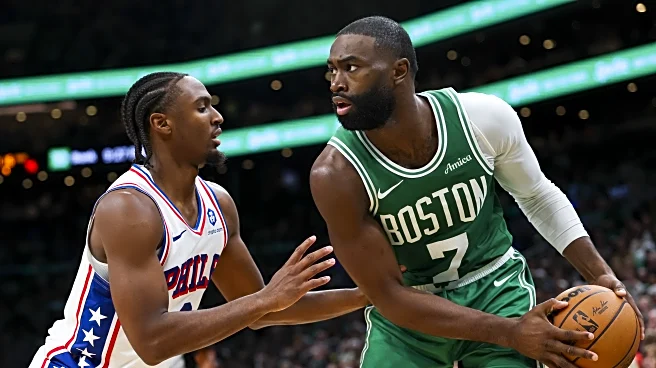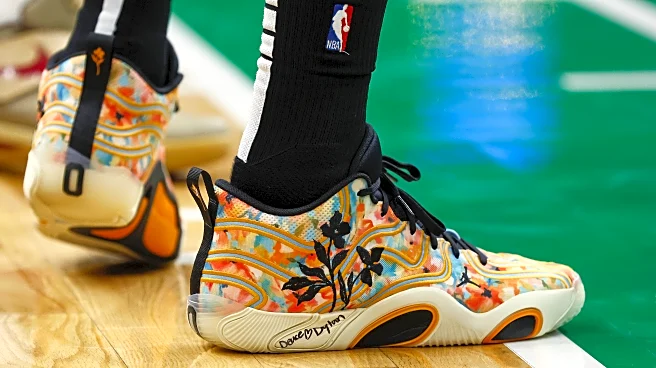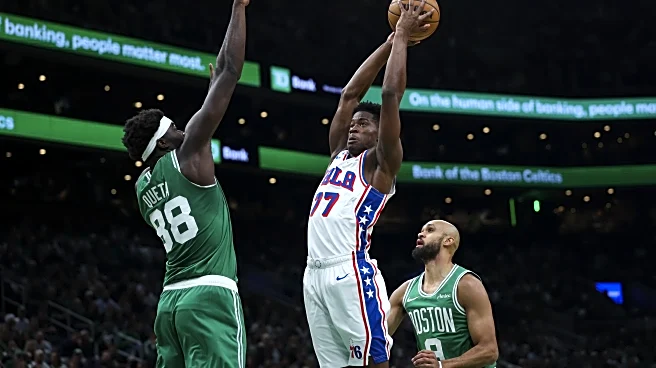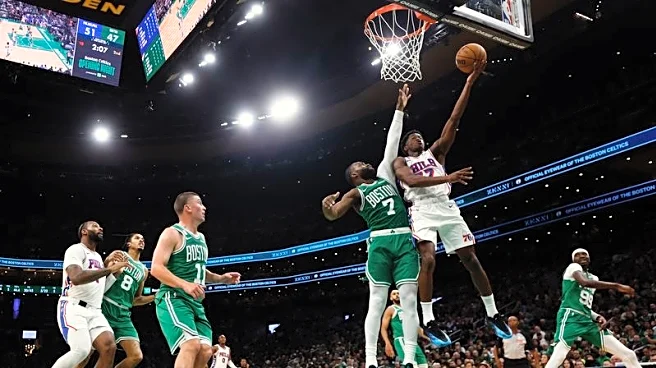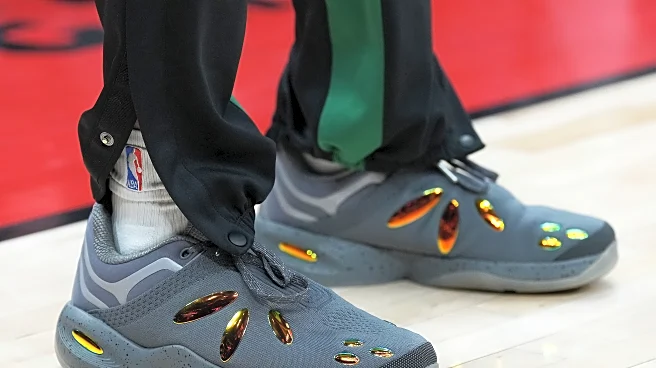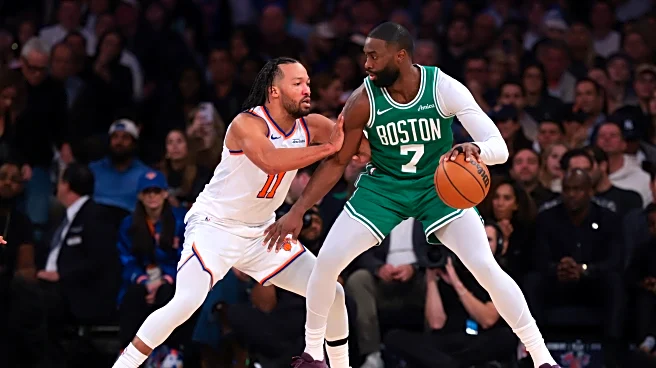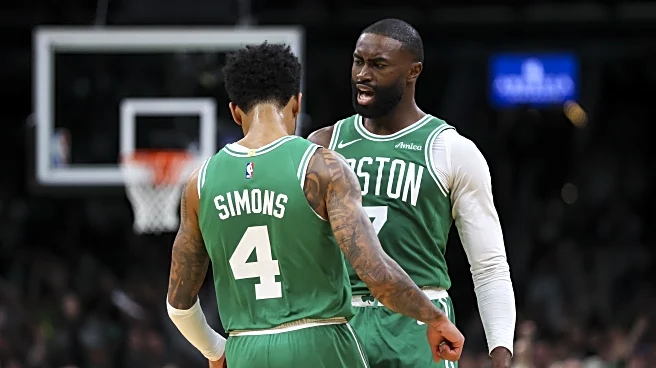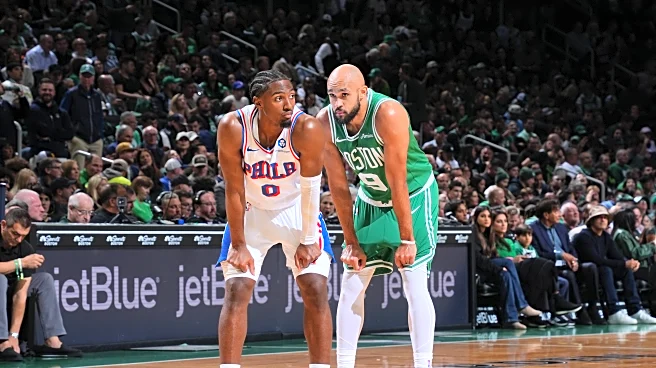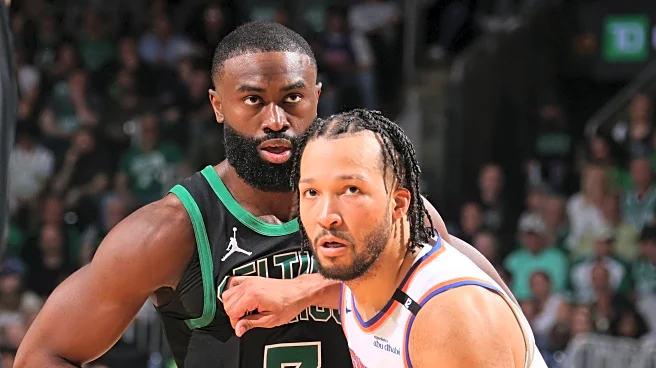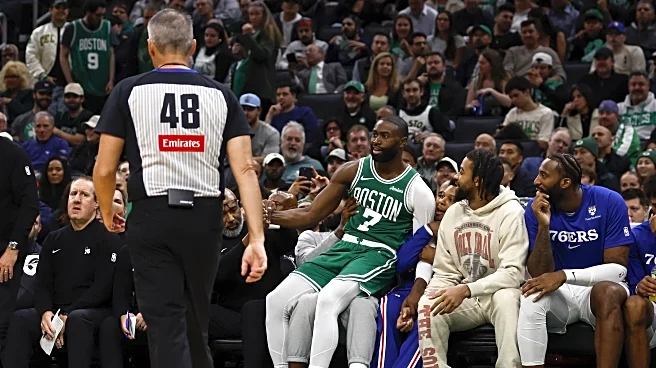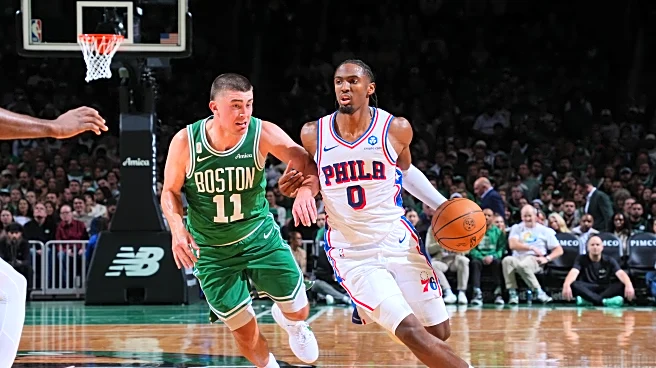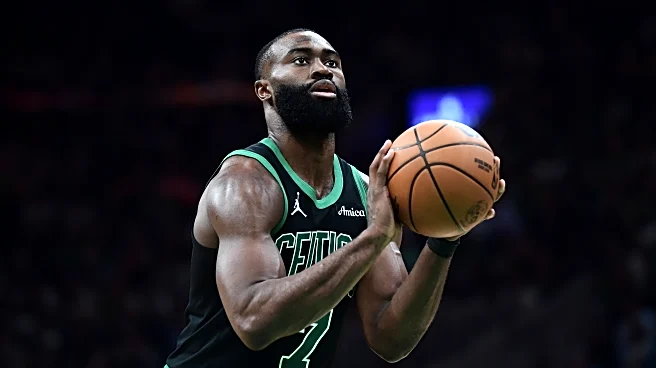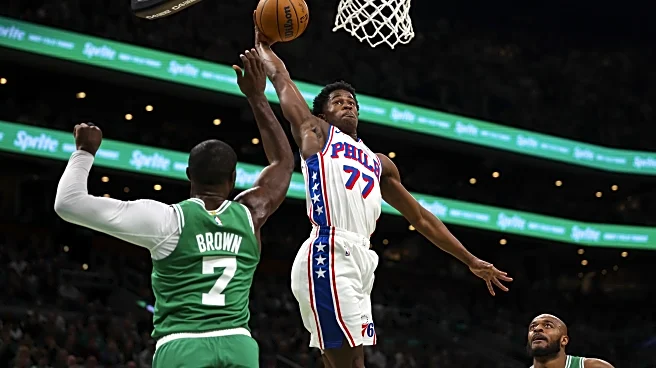#1 – Opening the season with a Spain PnR
Last season with the bench unit — especially with Payton Pritchard, Sam Hauser, and Luke Kornet — the Celtics ran a lot of Spain pick-and-rolls to generate rim attempts and open threes. This season, Pritchard and Hauser are part of the starting five, and the season started with this play.
With Neemias Queta as the first screener, Hauser as the second, and Derrick White as the ball-handler, the Celtics used this play to attack Joël Embiid’s drop coverage. As Hauser comes to set a screen on Embiid’s back,
the Sixers center can’t retreat to the rim, leaving Queta open.
This play was also used later with Simons as the ball-handler — a smart approach to create chaos in the defense. The multiplicity of screens forces the defense to communicate, which can lead to mistakes. On the first play, it created a shooting pocket for Simons.
The Celtics ran it a few more times in that game, and we’ll see more of these throughout the season. The execution of the screens and movements will be key to generating efficient offense around this play.
#2 – Jaylen Brown on Joël Embiid
Mister Joe Mazzulla loves inverted matchups, and he stuck to it last night. Without Jrue Holiday or Jayson Tatum, it was Jaylen Brown who took on the Joël Embiid assignment. While JB did his best to keep Embiid away, Queta could roam around the rim. Since Dominick Barlow is considered a non-shooter, the Portuguese big man could play the goalkeeper role in the paint.

This took away some easy attempts, and with Embiid’s lack of mobility and burst, it was easy enough for Brown to push him away from the paint. The Sixers tried to use screens to force better matchups for Embiid, but the Celtics were able to protect their own. In the play below, JB is forced to switch away from Embiid, so Queta leaves his player to tag the Sixers center while White rotates down to take Queta’s previous matchup.
This defensive assignment was enough to limit Embiid (who seems to be struggling with his body). Yet, despite a neutralized Embiid, the Celtics’ defense collapsed on multiple occasions — especially in the backcourt.
#3 – Defensive backcourt issues
We knew it was coming, but the drop-off in the Celtics’ backcourt defense was obvious — especially against such quick players as Tyrese Maxey and the rookie VJ Edgecombe. They combined for 26 buckets and 9 assists, with 34 points from the rookie in his first game.
Not to take anything away from Edgecombe’s unique performance, but the Celtics’ defense (and some shooting luck) definitely helped him out.
Both guards were quicker and more aggressive than the Celtics defenders, and they exploited the lack of ball pressure. On top of that, the Celtics’ defensive structure looks weaker than last year, not only in the backcourt. In the play below, White can’t contain Maxey, Brown’s help is useless, and Queta is set on the wrong side of the paint to have any impact at the rim.
The Celtics’ defense has been elite for the last few years thanks to ball pressure and rim protection, forcing opponents to take shots they didn’t want. Last night, the Sixers’ backcourt had a great offensive night because they could get to their spots easily. But while they were having fun on offense, the Celtics went back to their hunting habits.
#4 – Going after Maxey
The Sixers’ guard has been a target of the Celtics’ offense since he started his career, and there was no reason for that to change now. As soon as the game started, the Celtics went after him — and they kept doing it, with multiple players.
This often forced the Sixers to collapse in an effort to protect him, which created open looks for the Celtics.
Nonetheless, as Nik noticed, the Celtics stopped (maybe at the worst time) going after him. That was a missed opportunity, as attacking Maxey generates a double positive effect: first, it’s often good offense, and second, it forces him into foul trouble, which could take him out of the game.
#5 – Lack of ball movement
If the Celtics’ mismatch offense was still there last night, the ball movement wasn’t. Only 16 assists for 41 field goals made — that’s a 39% assist rate, the worst of any team last night, and far from the Celtics’ 2024–25 mark of 63%.
#6 – 25% from deep
The poor assist rate mentioned above is a direct consequence of the Celtics’ inability to convert catch-and-shoots — but it’s not only about shooting luck. While some of the Celtics’ shooters will have better nights than yesterday, this low percentage also tells a story.
The Celtics don’t have the same quality of creators anymore; therefore, there will be fewer gaps to exploit in opposing defenses, and catch-and-shoots will be harder to create. Also, the quality of their catch-and-shoot threats has decreased — the Celtics can’t expect Xavier Tillman, Chris Boucher, or Luka Garza to punish defenses like Kristaps Porzingis, Al Horford, and Jrue Holiday did.
The roster has changed. The approach needs to evolve too.
#7 – Where is the speed?
Speaking of the offensive approach — there was a lot of talk about speed and transition this summer. So, where did it go?
The ATO above is just one example, but the Celtics played at the same pace they’re used to. Plus, the transition emphasis that was brought up a lot during the offseason was missing too. Only 14 forced turnovers, leading to just 14 points generated from those defensive stops.
With this Celtics roster’s athleticism, there’s plenty of room to play faster and generate transition opportunities — but the offensive and defensive habits need to change.
#8 – Queta rim-running opportunities
Speaking of important habits to develop: using and finding Queta as a rim-runner. The Portuguese big man has improved a lot at creating space with his screens and flashing to the rim.
This creates many opportunities for easy buckets at the rim… but his teammates must learn to look for him. In the play below, it’s a perfect example of this habit not being there yet. After another good screen, Queta flashes to the rim, but Pritchard instead takes a step-back pull-up triple.
#9 – White leading the charge in the third
In the third, the Celtics’ guard took over and showed the importance of speed and attacking before the opponent’s defensive structure was set.
Often from the right, White made quick decisions to drive, attack on the pick-and-roll, or pull up when noticing the space the defense gave him.
Thanks to this aggressive approach, White scored 13 points in less than 8 minutes, generated 7 free throws, and got nothing but open looks.
#10 – Couldn’t convert in the last seconds
The Celtics had two opportunities to take the game in the last 10 seconds but weren’t able to generate good shots.
The execution of the first play didn’t create any gaps in the defense, and the Sixers were set when Pritchard received the ball. As soon as he drove, Brown came into the paint, which hurt the spacing. Meanwhile, the Sixers’ defenders collapsed to help on Grimes, leaving Hauser, Simons, and White open — but Pritchard went for a contested layup.
The second attempt gave Pritchard more space at first, but the spacing was once again poor. He didn’t have a clear path to the rim, so he faked and tried to sell a foul — but that didn’t work, and the Celtics took their first loss of the season.
